Korean salmon has a special place in my heart, and I can’t wait to share it with you!
The first time I tried it, the flavors of the gochujang glaze completely captivated me.
Each bite transports me back to the vibrant markets of Seoul, bursting with color and life.
And it doesn’t stop there—I’ve gathered a dozen delicious recipes that put a unique twist on this beloved fish.
Let’s explore these mouthwatering dishes together and bring a taste of Korea to your kitchen!
Gochujang Glazed Salmon
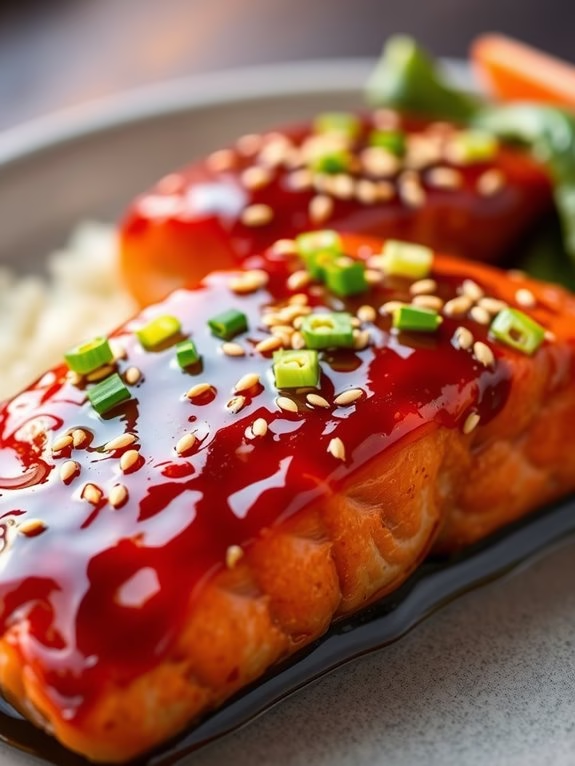
Gochujang Glazed Salmon is a delightful fusion dish that brings together the rich, savory flavors of Korean cuisine with the tender, flaky texture of fresh salmon. This recipe is perfect for those who enjoy a bit of spice and a lot of flavor. The gochujang, a Korean fermented red chili paste, plays the starring role in this dish, providing a unique depth of flavor that’s both sweet and spicy.
Paired with the natural richness of salmon, this glaze creates an irresistible combination that will have you coming back for more. This dish is relatively quick and straightforward to prepare, making it an excellent choice for weeknight dinners or casual gatherings with family and friends.
It’s also quite versatile, allowing you to serve it with a variety of side dishes such as steamed rice, sautéed vegetables, or a fresh salad. With its vibrant color and bold flavors, Gochujang Glazed Salmon is sure to impress your guests and provide a memorable dining experience.
Ingredients for 4-6 servings:
- 4-6 salmon fillets (about 6 oz each)
- 3 tablespoons gochujang (Korean chili paste)
- 2 tablespoons soy sauce
- 2 tablespoons honey
- 1 tablespoon rice vinegar
- 2 teaspoons sesame oil
- 3 cloves garlic, minced
- 1 teaspoon grated ginger
- 1 tablespoon sesame seeds
- 2 green onions, thinly sliced
- Salt and pepper to taste
Cooking Instructions:
- Preheat the Oven: Preheat your oven to 400°F (200°C). Preparing the oven first guarantees it reaches the right temperature by the time the salmon is ready to bake.
- Prepare the Glaze: In a small bowl, combine the gochujang, soy sauce, honey, rice vinegar, sesame oil, minced garlic, and grated ginger. Mix well until all ingredients are thoroughly combined to form a smooth glaze.
- Season the Salmon: Lightly season the salmon fillets with salt and pepper on both sides. This enhances the natural flavors of the salmon and balances the sweetness of the glaze.
- Apply the Glaze: Pat the salmon fillets dry with a paper towel, then brush the glaze generously over the top and sides of each fillet. Guarantee each piece is evenly coated.
- Bake the Salmon: Place the glazed salmon fillets on a baking sheet lined with parchment paper or lightly greased. Bake in the preheated oven for 12-15 minutes, or until the salmon is cooked through and flakes easily with a fork.
- Garnish and Serve: Once baked, remove the salmon from the oven and let it rest for a minute. Sprinkle with sesame seeds and sliced green onions before serving. This adds a fresh crunch and enhances the presentation.
Extra Tips:
To guarantee your salmon remains moist and tender, avoid overcooking. The baking time may vary slightly depending on the thickness of your salmon fillets, so keep an eye on them towards the end of the cooking time.
If you prefer a more intense flavor, allow the salmon to marinate in the gochujang glaze for about 30 minutes before baking. Additionally, you can adjust the amount of gochujang to suit your spice preference.
For a complete meal, consider serving the salmon with steamed jasmine rice or a side of lightly sautéed bok choy.
Soy-Ginger Salmon Sashimi
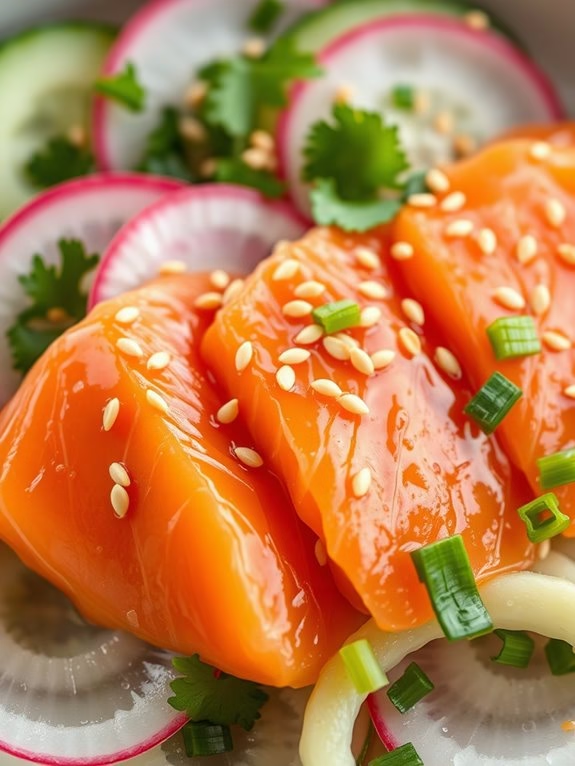
Soy-Ginger Salmon Sashimi offers a delightful fusion of flavors that celebrate both the freshness of the salmon and the rich, umami notes of soy and ginger. This dish is a perfect choice for those who appreciate the delicate taste of raw salmon enhanced by a simple yet flavorful marinade.
With its roots in Japanese cuisine, sashimi is a dish that emphasizes quality ingredients and precise preparation, allowing the natural flavors to shine through.
Preparing Soy-Ginger Salmon Sashimi requires fresh, high-quality salmon and a few key ingredients to create a harmonious balance of flavors. The soy-ginger marinade is a vital component, infusing the salmon with a savory, slightly spicy, and aromatic profile.
This dish isn’t only visually appealing but also offers a revitalizing and satisfying culinary experience, making it an excellent appetizer or a light main course.
Ingredients (serving size: 4-6 people):
- 1 pound fresh salmon fillet (sashimi grade)
- 1/4 cup soy sauce
- 2 tablespoons fresh ginger, grated
- 1 tablespoon rice vinegar
- 2 teaspoons sesame oil
- 1 tablespoon honey
- 1 tablespoon sesame seeds, toasted
- 1 small cucumber, thinly sliced
- 4-6 radishes, thinly sliced
- 2 scallions, thinly sliced
- 1 tablespoon fresh cilantro, chopped
Cooking Instructions:
- Prepare the Salmon: Start by verifying your salmon is of sashimi grade, meaning it’s safe to consume raw. Carefully remove the skin and any pin bones. Slice the salmon into thin, even pieces, about 1/4 inch thick. Arrange the slices on a serving platter.
- Make the Marinade: In a small mixing bowl, combine the soy sauce, grated ginger, rice vinegar, sesame oil, and honey. Mix well until the honey is fully dissolved and the marinade is well-blended.
- Marinate the Salmon: Pour the marinade over the arranged salmon slices, ensuring each piece is evenly coated. Allow the salmon to marinate in the refrigerator for about 10-15 minutes to absorb the flavors.
- Prepare the Garnishes: While the salmon is marinating, thinly slice the cucumber, radishes, and scallions. Toast the sesame seeds in a dry skillet over medium heat for about 2-3 minutes until golden brown. Chop the cilantro.
- Assemble the Dish: Once the salmon has marinated, garnish it with the sliced cucumber, radishes, and scallions. Sprinkle the toasted sesame seeds and chopped cilantro over the top for added flavor and texture.
- Serve: Serve the Soy-Ginger Salmon Sashimi immediately, allowing guests to enjoy the fresh and aromatic flavors. Pair it with a side of pickled ginger or wasabi for an authentic touch.
Extra Tips:
When preparing Soy-Ginger Salmon Sashimi, it’s vital to use the freshest salmon available to guarantee the best flavor and safest consumption.
Sashimi-grade salmon is specifically prepared to be eaten raw, minimizing the risk of parasites. If you’re unsure about the quality, consult a fishmonger or a trusted seafood supplier.
Additionally, if you prefer a bit more heat, consider adding a touch of wasabi to the marinade or serving it alongside the dish.
Finally, for a more visually striking presentation, use a mandoline to achieve uniformly thin slices of cucumber and radishes, adding to the dish’s elegance and appeal.
Kimchi Stew With Salmon
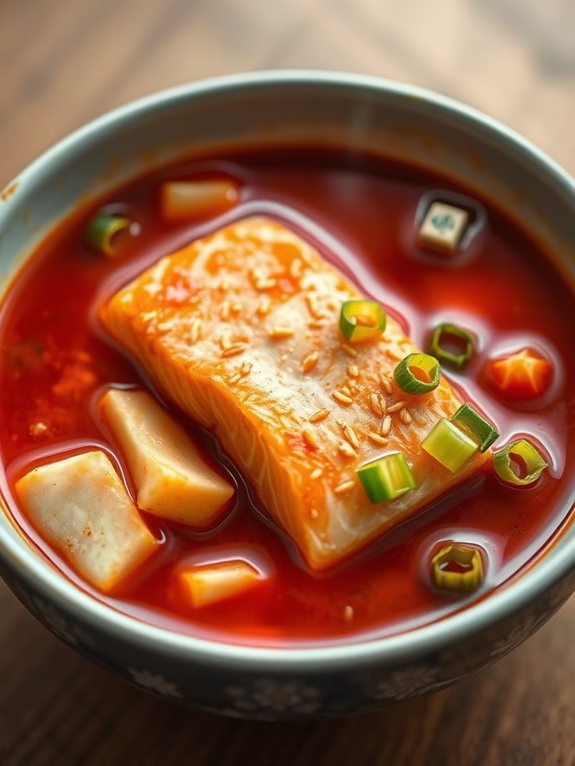
Kimchi Stew With Salmon is a delightful and savory dish that combines the bold flavors of traditional Korean kimchi with the rich, delicate taste of salmon. This fusion creates a comforting stew that’s both satisfying and nutritious, perfect for a hearty meal. The spicy and tangy kimchi pairs beautifully with the tender salmon, offering a unique and robust flavor profile that’s sure to please your palate.
The stew is relatively easy to prepare and is a great way to introduce salmon into your diet with a Korean twist. It’s perfect for those who enjoy experimenting with international cuisines and want to experience something different yet comforting. This recipe serves 4-6 people, making it an excellent choice for a family dinner or a small gathering with friends.
Ingredients:
- 4-6 pieces of salmon fillet (approximately 150g each)
- 2 cups of kimchi, chopped
- 1 medium onion, sliced
- 3 cloves of garlic, minced
- 1 tablespoon of gochujang (Korean red chili paste)
- 1 tablespoon of soy sauce
- 1 tablespoon of sesame oil
- 4 cups of chicken or vegetable broth
- 200g of tofu, cubed
- 2 green onions, sliced
- Salt and pepper to taste
- Cooked rice (optional, for serving)
Cooking Instructions:
- Prepare the Ingredients: Begin by gathering all your ingredients. Chop the kimchi, slice the onion, and mince the garlic. Rinse the salmon fillets under cold water, pat them dry with a paper towel, and set aside.
- Sauté Aromatics: In a large pot or Dutch oven, heat the sesame oil over medium heat. Add the sliced onion and minced garlic, and sauté for 2-3 minutes until the onion becomes translucent and the garlic is fragrant.
- Add Kimchi: Stir in the chopped kimchi and continue to cook for another 5 minutes. This will help release the flavors and juices from the kimchi, creating a flavorful base for your stew.
- Incorporate Broth and Seasonings: Pour in the chicken or vegetable broth, and add the gochujang and soy sauce. Stir well to combine. Bring the mixture to a simmer over medium-high heat.
- Simmer the Stew: Once the stew is simmering, reduce the heat to medium-low and let it cook for about 10 minutes. This allows the flavors to meld together.
- Add Tofu and Salmon: Gently add the cubed tofu and salmon fillets to the pot. Guarantee the salmon is submerged in the broth. Cover the pot and let it simmer for another 8-10 minutes, or until the salmon is cooked through and flakes easily with a fork.
- Season and Garnish: Taste the stew and adjust the seasoning with salt and pepper as needed. Sprinkle sliced green onions over the top before serving.
- Serve: Ladle the stew into bowls, guaranteeing each serving has a piece of salmon and a good mix of kimchi, tofu, and broth. Serve hot, with cooked rice on the side if desired.
Extra Tips:
When making Kimchi Stew With Salmon, it’s important to select a good-quality kimchi, as it’s the star ingredient that provides much of the stew’s flavor. If you prefer a milder stew, reduce the amount of gochujang or choose a less spicy kimchi.
Additionally, be gentle when adding the salmon to prevent it from breaking apart. If you’re a fan of extra spice, consider adding a dash of Korean red pepper flakes (gochugaru) for an added kick.
Finally, this stew can be easily adapted by adding vegetables such as mushrooms or zucchini for extra nutrition and variety.
Sesame Crusted Salmon

Sesame Crusted Salmon is a delightful fusion dish that combines the rich flavors of Korean cuisine with the succulent taste of salmon. This dish is perfect for anyone looking to impress their guests with a unique and mouthwatering meal. The sesame seeds provide a crunchy texture that pairs beautifully with the tender, juicy salmon, while the Korean-inspired marinade infuses the fish with deep, savory flavors.
This dish isn’t only a feast for the palate but also a visual delight, making it an ideal centerpiece for any dinner party or special occasion.
The preparation of Sesame Crusted Salmon is surprisingly simple, yet the results are spectacular. By using a few key Korean ingredients, such as soy sauce, sesame oil, and gochujang, you can elevate the natural flavor of the salmon to new heights. The marinade is quickly absorbed by the salmon, guaranteeing that each bite is bursting with flavor.
Coating the salmon with a generous layer of toasted sesame seeds adds a delightful crunch and enhances the overall presentation of the dish. Serve this dish with a side of steamed rice and a light salad for a complete and satisfying meal.
Ingredients (Serves 4-6):
- 4-6 salmon fillets (about 6 ounces each)
- 1/4 cup soy sauce
- 2 tablespoons sesame oil
- 2 tablespoons gochujang (Korean chili paste)
- 2 tablespoons honey
- 2 cloves garlic, minced
- 1 tablespoon fresh ginger, grated
- 1 cup sesame seeds
- 2 tablespoons vegetable oil
- Salt and pepper to taste
- Chopped green onions and sesame seeds for garnish
Cooking Instructions:
- Prepare the Marinade: In a medium bowl, combine the soy sauce, sesame oil, gochujang, honey, minced garlic, and grated ginger. Mix well until the honey is completely dissolved and all ingredients are thoroughly combined.
- Marinate the Salmon: Place the salmon fillets in a shallow dish or a resealable plastic bag. Pour the marinade over the salmon, guaranteeing each piece is well-coated. Let the salmon marinate in the refrigerator for at least 30 minutes, or up to 2 hours for a more intense flavor.
- Preheat the Oven: While the salmon is marinating, preheat your oven to 400°F (200°C).
- Coat with Sesame Seeds: Once marinated, remove the salmon from the fridge. Pour the sesame seeds onto a plate. Press each salmon fillet into the sesame seeds, coating both sides evenly.
- Sear the Salmon: Heat the vegetable oil in a large oven-safe skillet over medium-high heat. Add the sesame-crusted salmon fillets to the skillet, searing for about 2 minutes on each side until the sesame seeds are golden brown.
- Bake the Salmon: Transfer the skillet to the preheated oven. Bake for 8-10 minutes or until the salmon is cooked through and flakes easily with a fork.
- Garnish and Serve: Remove the salmon from the oven and let it rest for a few minutes. Garnish with chopped green onions and additional sesame seeds before serving. Serve with steamed rice and a light salad if desired.
Extra Tips:
When preparing Sesame Crusted Salmon, verify the salmon fillets are of even thickness for uniform cooking. If you prefer a spicier dish, increase the amount of gochujang in the marinade.
Toast the sesame seeds lightly before coating the salmon to enhance their nutty flavor. Make sure not to overcook the salmon; it should remain moist and tender. If you don’t have an oven-safe skillet, transfer the salmon to a baking dish after searing.
Enjoy the delectable flavors of Korea with this delightful and easy-to-make dish!
Korean BBQ Salmon Skewers
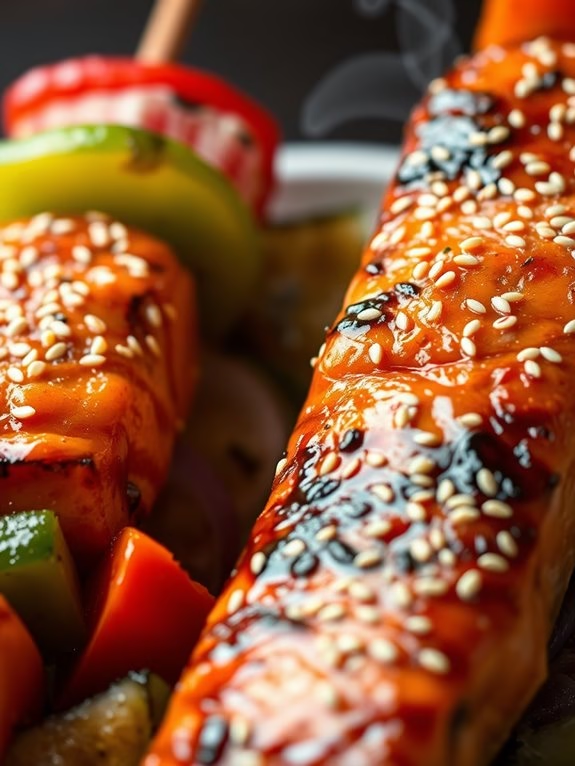
Indulge in the mouth-watering flavors of Korean BBQ with these delectable salmon skewers. Perfect for a summer cookout or a cozy indoor dinner, these skewers combine the rich taste of fresh salmon with the spicy, sweet, and savory notes of Korean BBQ sauce. The marinade, infused with traditional Korean spices and ingredients, penetrates the salmon, ensuring every bite is a burst of flavor.
Paired with vibrant vegetables, these skewers aren’t only delicious but also a visually appealing dish that will captivate your dinner guests. An ideal dish for serving 4-6 people, these Korean BBQ Salmon Skewers are straightforward to prepare, making them a great choice for both novice and experienced cooks.
The key to achieving the best flavor is allowing the salmon to marinate long enough to absorb the wonderful spices. Once skewered, the salmon and vegetables are grilled to perfection, providing a delightful combination of flavors and textures. Whether served as a main course or as part of a larger spread, these skewers are sure to be a hit.
Ingredients for 4-6 servings:
- 2 pounds fresh salmon fillets, skinless and boneless
- 1/2 cup soy sauce
- 1/4 cup honey
- 2 tablespoons sesame oil
- 3 cloves garlic, minced
- 1 tablespoon ginger, grated
- 2 tablespoons gochujang (Korean chili paste)
- 1 tablespoon rice vinegar
- 1 tablespoon sesame seeds
- 1 red bell pepper, cut into 1-inch pieces
- 1 green bell pepper, cut into 1-inch pieces
- 1 red onion, cut into wedges
- Skewers (wooden or metal)
Cooking Instructions:
- Prepare the Marinade: In a bowl, mix together the soy sauce, honey, sesame oil, minced garlic, grated ginger, gochujang, rice vinegar, and sesame seeds. Stir until the honey is fully dissolved and the mixture is well combined.
- Marinate the Salmon: Cut the salmon fillets into 1-inch cubes and place them in a large resealable plastic bag or a shallow dish. Pour the marinade over the salmon, ensuring all pieces are well coated. Seal the bag or cover the dish, and refrigerate for at least 1 hour, or up to 4 hours for more intense flavor.
- Prepare the Skewers: While the salmon is marinating, soak wooden skewers in water for at least 30 minutes to prevent burning. If using metal skewers, this step can be skipped.
- Assemble the Skewers: Remove the salmon from the marinade and thread the pieces onto the skewers, alternating with pieces of red bell pepper, green bell pepper, and red onion. Be sure to leave a little space between each piece for even cooking.
- Preheat the Grill: Preheat your grill to medium-high heat. If using a stovetop grill pan, heat it over medium-high heat.
- Grill the Skewers: Place the skewers on the grill and cook for about 8-10 minutes, turning occasionally, until the salmon is cooked through and has a slight char. The internal temperature of the salmon should reach 145°F (63°C).
- Serve: Once cooked, remove the skewers from the grill and let them rest for a couple of minutes before serving. Garnish with additional sesame seeds if desired.
Extra Tips:
For extra juicy salmon, avoid overcooking; the salmon should flake easily with a fork but still be moist. You can adjust the spice level by varying the amount of gochujang in the marinade to suit your taste.
If you don’t have a grill, these skewers can also be baked in the oven at 400°F (200°C) for about 12-15 minutes. To enhance the dish, serve the skewers with a side of steamed rice or a fresh salad to balance the bold flavors of the Korean BBQ marinade.
Spicy Salmon Bibimbap
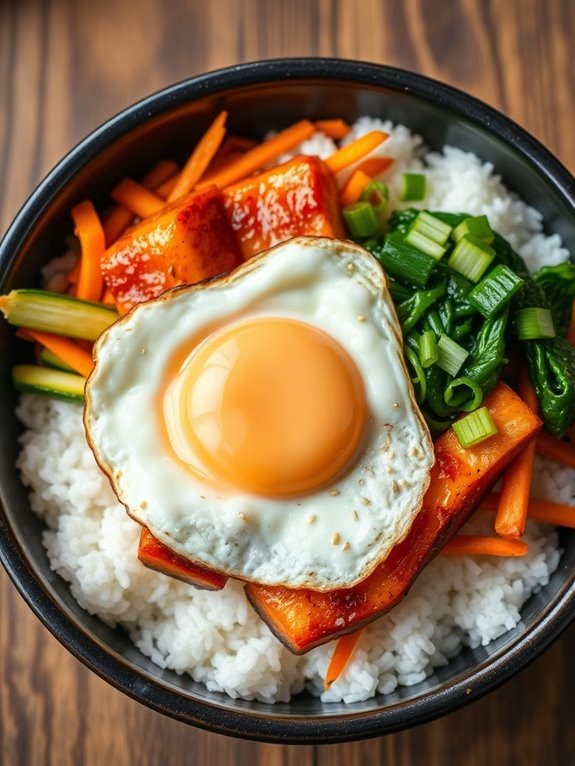
Spicy Salmon Bibimbap is a vibrant and flavorful Korean dish that combines the rich taste of salmon with an array of fresh vegetables, all brought together with a spicy, tangy sauce. This dish isn’t only delicious but also visually appealing, making it a perfect choice for a family meal or a special occasion. The traditional bibimbap is a mixed rice dish, where “bibim” means mixing various ingredients and “bap” refers to rice. In this version, the addition of salmon provides a hearty and nutritious twist, packed with omega-3 fatty acids and protein.
The beauty of Spicy Salmon Bibimbap lies in its versatility and balance of flavors. Each component of the dish, from the marinated salmon to the crisp vegetables and the spicy gochujang sauce, plays an essential role in creating a harmonious blend of taste and texture. Served over a bed of steamed rice, this dish is both satisfying and nourishing. Whether you’re new to Korean cuisine or a seasoned enthusiast, Spicy Salmon Bibimbap is a must-try recipe that showcases the depth and diversity of Korean flavors.
Ingredients (serving size: 4-6 people):
- 1 1/2 lbs salmon fillets, skinless
- 2 cups short-grain white rice
- 3 cups water
- 2 tablespoons sesame oil
- 1 tablespoon soy sauce
- 1 tablespoon gochugaru (Korean chili flakes)
- 3 tablespoons gochujang (Korean chili paste)
- 2 tablespoons rice vinegar
- 2 tablespoons honey
- 3 cloves garlic, minced
- 1 teaspoon ginger, grated
- 1 bunch spinach, blanched
- 1 large carrot, julienned
- 1 zucchini, julienned
- 2 cups bean sprouts
- 4 eggs
- 2 tablespoons vegetable oil
- Sesame seeds, for garnish
- Sliced green onions, for garnish
Cooking Instructions:
- Prepare the Rice: Rinse the rice under cold water until the water runs clear. Combine the rice and 3 cups of water in a rice cooker or pot. Cook according to the rice cooker instructions or bring to a boil, then reduce heat to low, cover, and simmer for 15-20 minutes until the rice is tender and water is absorbed.
- Marinate the Salmon: In a bowl, mix 1 tablespoon of sesame oil, soy sauce, gochugaru, 2 tablespoons of gochujang, rice vinegar, honey, minced garlic, and grated ginger. Cut the salmon into bite-sized pieces and coat them with the marinade. Let it sit for at least 20 minutes to absorb the flavors.
- Cook the Salmon: Heat 1 tablespoon of vegetable oil in a skillet over medium heat. Add the marinated salmon pieces and cook for 3-4 minutes on each side, or until the salmon is cooked through and slightly caramelized. Remove from the skillet and set aside.
- Prepare the Vegetables: In the same skillet, add another tablespoon of vegetable oil and sauté the julienned carrots, zucchini, and bean sprouts separately until they’re tender-crisp. Lightly season with salt if desired. Blanch the spinach in boiling water for 1-2 minutes, then drain and squeeze out excess water.
- Fry the Eggs: In a clean pan, heat a small amount of oil over medium heat. Fry the eggs sunny-side-up or to your preference. The runny yolk adds a delicious richness to the bibimbap.
- Assemble the Bibimbap: Divide the cooked rice into bowls. Arrange the cooked salmon, sautéed vegetables, and spinach around the rice. Place a fried egg on top of each bowl.
- Garnish and Serve: Drizzle the remaining gochujang over the top, and garnish with sesame seeds and sliced green onions. Mix everything together before eating to enjoy the full flavor profile.
Extra Tips:
For an added layer of flavor, consider using a stone pot (dolsot) to serve the bibimbap. Heating the pot before adding the rice creates a delicious crispy layer at the bottom. If you prefer a less spicy version, adjust the amount of gochujang and gochugaru to suit your taste.
Feel free to add other vegetables like mushrooms or bell peppers based on seasonal availability or personal preference. Remember, the key to a great bibimbap is in balancing the ingredients, so don’t hesitate to experiment and make it your own!
Miso Soup With Salmon
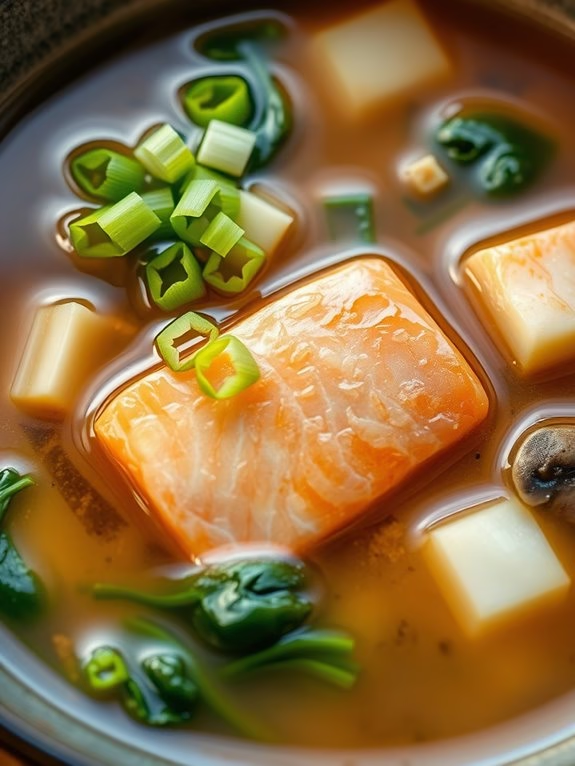
Miso soup with salmon is a delightful fusion of rich, savory flavors and healthful ingredients. This traditional Japanese dish is elevated with the addition of succulent salmon fillets, offering a satisfying depth of taste and texture. The combination of miso paste, dashi broth, and fresh vegetables creates a comforting and nourishing soup that’s perfect for any occasion.
Whether you’re looking to impress guests with an elegant appetizer or simply want a wholesome meal, this recipe is bound to please.
The key to a perfect miso soup with salmon lies in the balance of flavors and the quality of ingredients. Miso paste provides a salty, umami-rich base, while the salmon adds a hearty, protein-packed element. Complemented by an assortment of vegetables such as mushrooms, tofu, and green onions, this soup is both visually appealing and deeply satisfying.
Follow the recipe below to create a delicious, warming bowl of miso soup with salmon for 4-6 people.
Ingredients:
- 1 lb salmon fillets, skinless and boneless
- 6 cups dashi broth
- 1/2 cup white miso paste
- 1 block of firm tofu, cubed
- 1 cup sliced mushrooms (shiitake or button)
- 1 cup chopped spinach or bok choy
- 1/4 cup sliced green onions
- 1 tablespoon soy sauce
- 1 tablespoon sake (optional)
- Salt and pepper to taste
Instructions:
- Prepare the Ingredients: Start by cutting the salmon into bite-sized pieces and cubing the tofu. Slice the mushrooms and chop the spinach or bok choy. Set the ingredients aside.
- Make the Base: In a large pot, bring the dashi broth to a gentle simmer over medium heat. If you’re using sake, add it to the broth for an extra layer of flavor.
- Cook the Salmon: Gently add the salmon pieces to the pot and let them poach in the simmering broth for about 5-7 minutes, or until they’re cooked through and opaque.
- Add the Vegetables and Tofu: Stir in the mushrooms, tofu, and spinach or bok choy. Allow these to cook for another 3-4 minutes until the vegetables are tender.
- Incorporate the Miso Paste: In a separate bowl, mix the miso paste with a ladleful of the hot broth until smooth. Gradually stir this mixture back into the pot, making certain it’s well combined without boiling the soup, as boiling can diminish the flavor of the miso.
- Season the Soup: Add the soy sauce and adjust the seasoning with salt and pepper to taste. Allow the soup to warm through for an additional minute or two.
- Finish and Serve: Remove the pot from heat and sprinkle the sliced green onions over the soup. Serve hot in individual bowls, making sure each bowl has a generous portion of salmon and vegetables.
Extra Tips:
To guarantee the salmon remains tender and moist, avoid overcooking it in the broth. It’s best to add the miso paste just before serving to retain its delicate flavors and nutritional benefits.
If you prefer a spicier kick, consider adding a dash of chili oil or a sprinkle of togarashi (Japanese chili powder) before serving. For a richer taste, consider adding a touch of sesame oil.
Additionally, you can customize the soup by adding other vegetables like carrots or daikon radish based on your preference. Enjoy this delicious miso soup with a side of steamed rice or enjoy it on its own as a fulfilling meal.
Sweet and Spicy Salmon
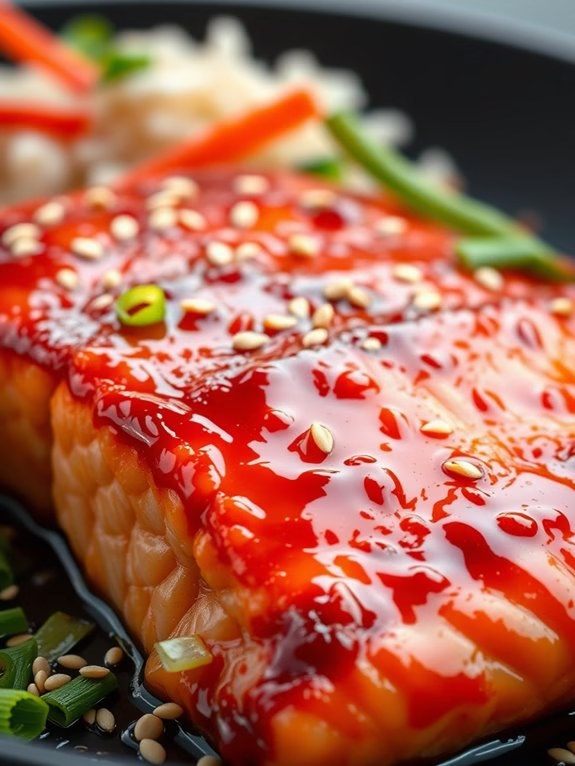
Sweet and Spicy Korean Salmon is a delicious and flavorful dish that combines the perfect balance of sweetness and heat, capturing the essence of Korean cuisine. This recipe features fresh salmon fillets marinated in a delightful mixture of soy sauce, honey, ginger, and chili paste, which infuses the fish with a rich blend of flavors. The result is a dish that isn’t only visually appealing but also tantalizing to the taste buds, making it an excellent choice for a family dinner or a special occasion.
The preparation begins with selecting high-quality salmon fillets, guaranteeing they’re fresh and free from any unpleasant odors. The marinade, which is the heart of this dish, is a simple yet effective blend of Korean-inspired ingredients that enhance the natural flavors of the salmon.
After allowing the salmon to absorb the marinade, it’s then cooked to perfection, resulting in a tender and juicy fish with a caramelized glaze that’s both sweet and spicy. This dish is best served with steamed rice and a side of vegetables to complement the vibrant flavors of the salmon.
Ingredients (Serves 4-6):
- 4-6 salmon fillets (about 6 oz each)
- 1/4 cup soy sauce
- 1/4 cup honey
- 2 tablespoons gochujang (Korean chili paste)
- 1 tablespoon sesame oil
- 2 tablespoons rice vinegar
- 3 cloves garlic, minced
- 1 tablespoon grated fresh ginger
- 1 tablespoon sesame seeds
- 3 green onions, sliced
- Salt and pepper to taste
Cooking Instructions:
- Prepare the Marinade: In a medium bowl, combine soy sauce, honey, gochujang, sesame oil, rice vinegar, minced garlic, and grated ginger. Whisk the ingredients together until they’re well incorporated, forming a smooth marinade.
- Marinate the Salmon: Place the salmon fillets in a shallow dish or a resealable plastic bag. Pour the marinade over the salmon, guaranteeing all fillets are evenly coated. Cover the dish or seal the bag and refrigerate for at least 30 minutes to allow the flavors to penetrate the salmon.
- Preheat the Oven: Preheat your oven to 400°F (200°C). While the oven is heating, remove the salmon from the refrigerator and let it sit at room temperature for about 10 minutes.
- Bake the Salmon: Line a baking sheet with parchment paper or lightly oil it. Arrange the salmon fillets on the prepared baking sheet, skin-side down. Bake in the preheated oven for 12-15 minutes, or until the salmon is cooked through and flakes easily with a fork. The cooking time may vary depending on the thickness of the fillets.
- Garnish and Serve: Once the salmon is cooked, remove it from the oven and transfer it to a serving platter. Sprinkle the salmon with sesame seeds and sliced green onions. Serve immediately with steamed rice and your choice of vegetables.
Extra Tips:
For an extra kick, adjust the amount of gochujang to your taste preference. If you prefer a less spicy dish, reduce the amount, or add more for increased heat.
Always guarantee the salmon is cooked to an internal temperature of 145°F (63°C) for safe consumption. If you’re using frozen salmon, make sure it’s fully thawed before marinating to ensure even flavor absorption.
Additionally, this recipe can be adapted by grilling the salmon instead of baking for a slightly smoky flavor.
Salmon and Seaweed Rolls
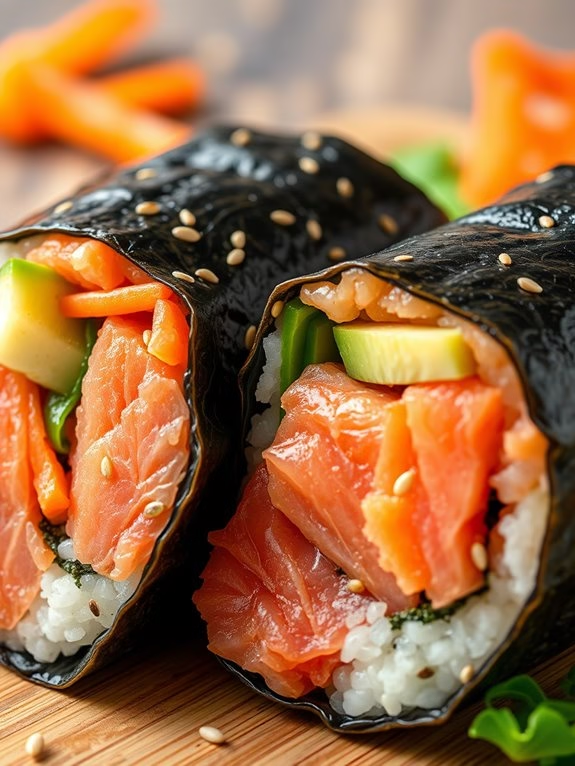
Korean Salmon and Seaweed Rolls are a delightful fusion of flavors, combining the rich taste of salmon with the umami of seaweed. This dish isn’t only visually appealing but also packed with nutrition, making it a perfect appetizer or a light main course. The rolls are wrapped in nori, a type of seaweed, which adds a unique texture and flavor, while the inside is filled with a savory mixture of fresh salmon, rice, and Korean-inspired seasonings.
Ideal for family gatherings or a special dinner, these rolls are sure to impress your guests with their vibrant colors and delectable taste.
To prepare Korean Salmon and Seaweed Rolls, you need to guarantee the salmon is fresh and of high quality, as it forms the main flavor component. The rice should be well-cooked and seasoned with a mix of rice vinegar and sugar to achieve that perfect sticky texture which holds everything together. The rolls can be served with a side of soy sauce or a spicy Korean dipping sauce for an extra kick. This recipe serves 4-6 people, making it an excellent choice for sharing or entertaining.
Ingredients:
- 2 cups sushi rice
- 2 1/2 cups water
- 1/4 cup rice vinegar
- 2 tablespoons sugar
- 1 teaspoon salt
- 1 1/2 pounds fresh salmon fillet, skin removed
- 6 sheets of nori (seaweed)
- 1 cucumber, julienned
- 1 carrot, julienned
- 1 avocado, sliced
- 2 tablespoons sesame oil
- 2 tablespoons soy sauce
- 1 tablespoon gochujang (Korean red chili paste)
- 1 tablespoon sesame seeds
- Optional: pickled ginger and wasabi for serving
Instructions:
- Prepare the Rice: Rinse the sushi rice under cold water until the water runs clear. Combine the rice with 2 1/2 cups of water in a rice cooker or pot. Cook according to the rice cooker instructions or bring to a boil, then simmer covered for about 15 minutes. Let it stand off the heat, covered, for another 10 minutes.
- Season the Rice: In a small saucepan, combine the rice vinegar, sugar, and salt. Heat gently until the sugar dissolves. Transfer the cooked rice to a large bowl, and slowly pour the vinegar mixture over it, folding the rice gently to mix. Let it cool to room temperature.
- Prepare the Salmon: Cut the salmon fillet into thin strips, about 1/2 inch wide. In a small bowl, mix the sesame oil, soy sauce, and gochujang. Marinate the salmon strips in this mixture while you prepare the other ingredients.
- Prepare the Vegetables: Julienne the cucumber and carrot, and slice the avocado. Set aside.
- Assemble the Rolls: Place a sheet of nori on a bamboo sushi mat, shiny side down. Spread about 1/2 cup of the seasoned rice evenly over the nori, leaving a 1-inch border at the top edge. Lay a few strips of salmon, cucumber, carrot, and avocado across the center of the rice.
- Roll the Sushi: Using the bamboo mat, roll the nori over the filling, pressing gently but firmly to keep the roll tight. Continue rolling until you reach the border. Dampen the edge with a little water to seal the roll.
- Slice the Rolls: Using a sharp knife, cut each roll into 6-8 pieces. Wipe the knife with a damp cloth between cuts to guarantee clean slices.
- Garnish and Serve: Arrange the rolls on a platter, sprinkle with sesame seeds, and serve with pickled ginger, wasabi, and soy sauce on the side.
Extra Tips:
When making Korean Salmon and Seaweed Rolls, guarantee your knife is very sharp, as a dull knife can tear the nori and squash the rolls.
If you’re new to rolling sushi, practice with just rice at first to get a feel for the technique. Additionally, keep a bowl of water nearby to wet your hands and the knife frequently, preventing the rice from sticking.
Finally, consider using a non-stick cooking spray on the bamboo mat to make rolling easier and less messy.
Korean Salmon Pancakes
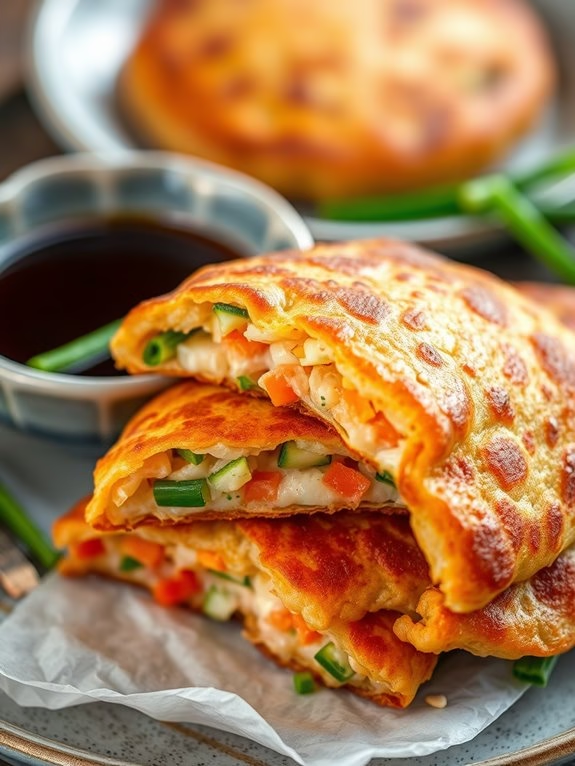
Korean Salmon Pancakes, known as “Salmon Jeon” in Korean, are a delightful fusion of Korean flavors and the rich, delicate taste of salmon. This dish combines the savory notes of traditional Korean pancakes with the nutritious benefits of salmon, making it a perfect appetizer or main course.
These pancakes are crispy on the outside, tender on the inside, and are often enjoyed with a soy sauce-based dipping sauce that complements the flavors beautifully. Ideal for a serving size of 4-6 people, Korean Salmon Pancakes are a great choice for parties or family gatherings.
The preparation involves mixing salmon with various vegetables and seasonings, then frying the mixture into golden-brown pancakes. The process is relatively straightforward, allowing even novice cooks to enjoy making this delicious dish at home. Serve these pancakes with a dipping sauce for a complete and satisfying meal.
Ingredients:
- 1 lb salmon fillet, skinless and boneless
- 1 cup all-purpose flour
- 1/2 cup potato starch (or cornstarch)
- 2 large eggs
- 1/2 cup scallions, finely chopped
- 1/2 cup carrots, finely shredded
- 1/2 cup zucchini, finely shredded
- 3 cloves garlic, minced
- 1 tbsp soy sauce
- 1 tbsp sesame oil
- 1 tsp salt
- 1/2 tsp black pepper
- Vegetable oil for frying
Cooking Instructions:
- Prepare the Salmon: Begin by finely chopping the salmon fillet into small pieces. Verify there are no bones or skin present. Place the chopped salmon into a large mixing bowl.
- Mix the Vegetables: Add the finely chopped scallions, shredded carrots, and zucchini to the bowl with the salmon. These vegetables will add flavor and texture to the pancakes.
- Create the Batter: In a separate bowl, combine the all-purpose flour and potato starch. Add the two eggs, soy sauce, sesame oil, minced garlic, salt, and black pepper. Mix well until you have a smooth batter.
- Combine Ingredients: Pour the batter over the salmon and vegetable mixture. Stir everything together until the ingredients are well combined and coated in the batter.
- Heat the Oil: In a large non-stick skillet, heat a generous amount of vegetable oil over medium-high heat. The oil should be hot enough that a small drop of batter sizzles upon contact.
- Fry the Pancakes: Spoon heaping tablespoons of the salmon mixture into the skillet, flattening each scoop into a pancake shape. Be sure not to overcrowd the pan. Cook for 3-4 minutes on each side, or until golden brown and crispy.
- Drain and Serve: Once cooked, remove the pancakes from the skillet and drain on paper towels to remove excess oil. Serve immediately with a side of soy sauce or your favorite Korean dipping sauce.
Extra Tips:
To guarantee even cooking and a crispy texture, make sure the pancakes aren’t too thick. If you find the batter too thick, you can add a bit of water to reach your desired consistency.
Additionally, keep the oil at a consistent temperature; if it gets too hot, the pancakes may burn on the outside while remaining raw on the inside. If you’re making larger batches, you can keep cooked pancakes warm in a low oven while frying the rest. Enjoy your Korean Salmon Pancakes fresh for the best taste and texture.
Grilled Salmon Lettuce Wraps
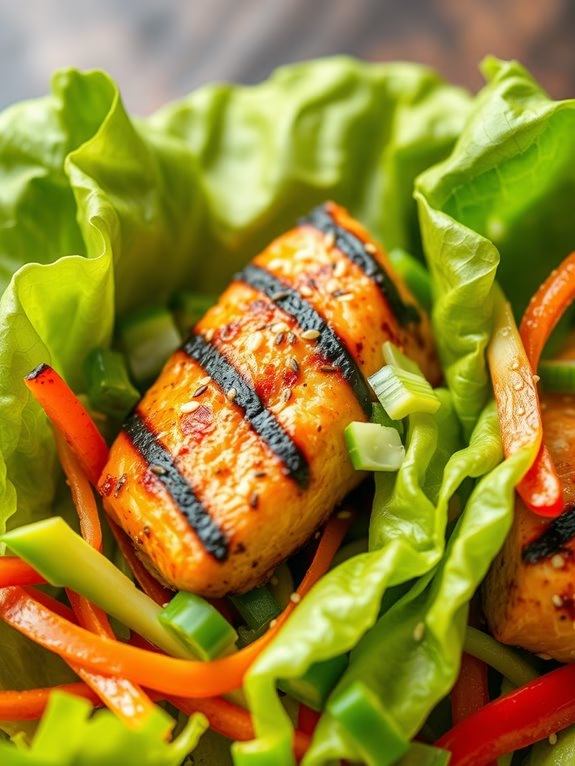
Grilled Salmon Lettuce Wraps are a delightful and healthy way to enjoy the rich flavors of Korean cuisine. This dish combines the smoky and savory taste of grilled salmon with the fresh and crisp texture of lettuce, creating a perfect balance of flavor and texture. The salmon is marinated in a mix of Korean-inspired ingredients, adding depth and a hint of spice, while the lettuce provides a revitalizing crunch that complements the fish beautifully. Perfect for a light lunch or a healthy dinner, these wraps are both nutritious and satisfying.
The preparation of Grilled Salmon Lettuce Wraps is both straightforward and rewarding. You begin by marinating the salmon fillets in a flavorful mixture, allowing the fish to absorb the savory and spicy notes. Once marinated, the salmon is grilled to perfection, achieving a tender, flaky interior and a slightly charred exterior.
The grilled salmon is then wrapped in crisp lettuce leaves, accompanied by a variety of fresh vegetables and a drizzle of sauce, which adds an extra layer of flavor. This dish isn’t only easy to prepare but also offers a vibrant presentation that’s sure to impress.
Ingredients (serving size: 4-6 people):
- 4 salmon fillets (about 6 oz each)
- 1 tablespoon soy sauce
- 1 tablespoon sesame oil
- 2 tablespoons gochujang (Korean chili paste)
- 2 cloves garlic, minced
- 1 teaspoon grated ginger
- 1 tablespoon rice vinegar
- 1 tablespoon honey
- 1 head of butter lettuce or romaine lettuce
- 1 cucumber, julienned
- 1 carrot, julienned
- 1 red bell pepper, sliced thinly
- 1 tablespoon sesame seeds
- 2 green onions, chopped
- Optional: 1 avocado, sliced
- Salt and pepper to taste
Instructions:
- Prepare the Marinade: In a bowl, combine soy sauce, sesame oil, gochujang, minced garlic, grated ginger, rice vinegar, and honey. Mix well until all ingredients are incorporated.
- Marinate the Salmon: Place the salmon fillets in a shallow dish and pour the marinade over them, making certain each fillet is well coated. Cover and refrigerate for at least 30 minutes, or up to 2 hours for a more intense flavor.
- Preheat the Grill: Preheat your grill to medium-high heat. Lightly oil the grill grates to prevent sticking.
- Grill the Salmon: Remove the salmon from the marinade and place them on the grill. Cook each side for 4-5 minutes, or until the salmon is cooked through and has a nice char on the outside.
- Prepare the Vegetables: While the salmon is grilling, wash and separate the lettuce leaves. Julienne the cucumber and carrot, and slice the red bell pepper.
- Assemble the Wraps: Once the salmon is cooked, flake it into bite-sized pieces. Take a lettuce leaf, add a few pieces of salmon, and top with cucumber, carrot, red bell pepper, and green onions. Sprinkle with sesame seeds.
- Serve: Arrange the wraps on a platter and serve immediately. Optionally, add avocado slices for extra creaminess.
Extra Tips:
To enhance the flavor of your Grilled Salmon Lettuce Wraps, consider using a charcoal grill for a smoky taste that pairs well with the marinade. If you don’t have a grill, a grill pan or broiler can be used as alternatives.
For added freshness, squeeze a little lime juice over the wraps before serving. If you prefer a spicier wrap, increase the amount of gochujang or add sliced jalapeños. Finally, verify the lettuce leaves are thoroughly dried to maintain their crispness when serving.
Salmon With Korean Rice Cake
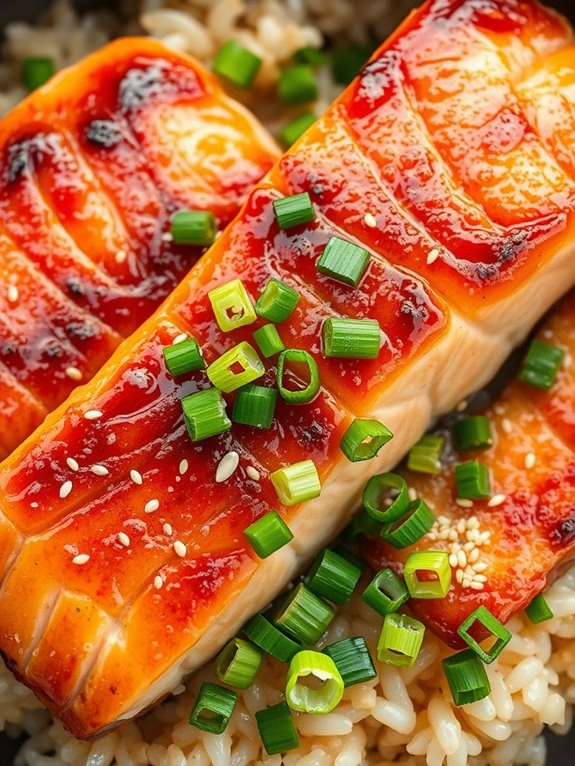
Salmon with Korean Rice Cake is a delightful fusion dish that combines the rich flavors of salmon with the chewy texture of Korean rice cakes, or “tteok.” This dish is a harmonious blend of savory, spicy, and slightly sweet flavors, making it a comforting and satisfying meal. The salmon is marinated in a Korean-inspired sauce that enhances its natural flavors, while the rice cakes provide a unique texture that complements the tender fish.
This recipe is perfect for a family dinner or a special occasion, offering a taste of Korean cuisine with a focus on fresh, high-quality ingredients. The combination of salmon and rice cakes creates a balanced dish that’s both nutritious and delicious. It’s an excellent way to introduce Korean flavors to your culinary repertoire, and it’s sure to become a favorite for those who enjoy trying new and exciting dishes.
Ingredients (Serving Size: 4-6 people):
- 1.5 pounds of salmon fillets
- 2 cups of Korean rice cakes (tteok)
- 3 tablespoons of soy sauce
- 2 tablespoons of gochujang (Korean chili paste)
- 1 tablespoon of sesame oil
- 1 tablespoon of honey
- 3 cloves of garlic, minced
- 1 inch piece of ginger, grated
- 2 tablespoons of rice vinegar
- 1 tablespoon of vegetable oil
- 1 bunch of green onions, chopped
- 1 tablespoon of sesame seeds
- Salt and pepper to taste
Cooking Instructions:
- Prepare the Marinade: In a medium bowl, combine the soy sauce, gochujang, sesame oil, honey, minced garlic, grated ginger, and rice vinegar. Mix well to create a smooth marinade.
- Marinate the Salmon: Place the salmon fillets in a shallow dish and pour half of the marinade over them. Be certain the salmon is evenly coated. Cover the dish and let it marinate in the refrigerator for at least 30 minutes.
- Cook the Rice Cakes: While the salmon marinates, bring a pot of water to a boil. Add the Korean rice cakes and cook for about 5 minutes or until they become soft. Drain and set aside.
- Sear the Salmon: Heat the vegetable oil in a large skillet over medium-high heat. Remove the salmon from the marinade, allowing any excess to drip off. Season the fillets with salt and pepper, then sear them skin-side down for about 3-4 minutes until the skin is crispy. Flip the fillets and cook for another 3-4 minutes until the salmon is cooked through.
- Combine Ingredients: Reduce the heat to medium and add the cooked rice cakes to the skillet. Pour the remaining marinade over the rice cakes and salmon, gently tossing to coat everything evenly. Cook for an additional 2-3 minutes until the rice cakes absorb the flavors.
- Garnish and Serve: Remove the skillet from the heat. Sprinkle the chopped green onions and sesame seeds over the top. Serve the salmon and rice cakes on a large platter or individual plates.
Extra Tips:
When cooking Salmon with Korean Rice Cake, ascertain that the salmon fillets are of similar thickness to cook evenly. If you prefer a less spicy dish, reduce the amount of gochujang in the marinade.
You can also add vegetables such as bell peppers or broccoli for additional flavor and nutrition. If the rice cakes are particularly firm, soak them in warm water for 10-15 minutes before cooking to soften them further.
Enjoy this dish with a side of steamed rice or a simple salad to complete the meal.

